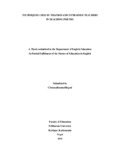Please use this identifier to cite or link to this item:
https://elibrary.tucl.edu.np/handle/123456789/1520| Title: | Techniques Used by Trained bnd Untrained Teachers in Teaching Poetry |
| Authors: | Regmi, ChetanaKumari |
| Keywords: | teacher training;Teaching method;Poetry |
| Issue Date: | 2015 |
| Publisher: | Faculty of Education, Tribhuvan University Kirtipur |
| Abstract: | This thesis entitled Techniques used by Trained and Untrained teachers in Teaching Poetry is an attempt to find out the strategies in teaching and learning poetry at secondary level. This study has tried to compare the strategies used by trained and untrained teachers at secondary level. Questionnaire and class observation were used as the tools to collect the data. The researcher purposively selected ten secondary schools. All together thirty students and ten teachers were selected from ten schools using purposive non- random sampling procedure. The researcher used class observations check list. The researcher observed the three classeseach of ten teachers while they taught poetry and filled up the class observation from. It was found that trained teacher used most of the techniques more frequently than the untrained teachers. It was also found that some of the techniques were used by both types of teachers in all classes while teaching poetry. In this way some of the techniques not used by any teachers for example: asking for choral reading, introducing rhetorical devices and introducing tone of the poem. This study consists of five chapters. Chapter one is introduction which consists of background of the study, statement of the problem, objectives of the study, research questions, significance of the study, delimitations of the study and operational definitions of the key terms. Similarly chapter two deals with the review of related literature and conceptual framework. It encompasses review of theoretical and empirical literature, implications of the review for the study and conceptual framework. Chapter three includes methods and procedures used in the study which includes methods and designs, population, sample and sampling strategies study area/field, data collection tools and data collection procedures. Similarly, Chapter four entails analysis and interpretation of the result and summary of the findings. Chapter five includes conclusion and recommendations. Finally, this chapter is followed by references and appendices. |
| URI: | http://elibrary.tucl.edu.np/handle/123456789/1520 |
| Appears in Collections: | English Language Education |
Items in DSpace are protected by copyright, with all rights reserved, unless otherwise indicated.

